Annunciation and Agony
Sacred buildings and requisites for divine worship should be truly worthy and beautiful and be signs and symbols of heavenly realities. (General Instruction of the Roman Missal: NZ Edition, 288)
In the last two issues of the Messenger this column addressed the sanctuary of St Francis de Sales and All Souls in Devonport. One feature identified was the strong left/right symmetry of the whole building and of the sanctuary in particular. This symmetry invites us to look at the two windows of that sanctuary in parallel. They are individually beautiful, but seen together they are stunning and profound.
The parish website declares the sanctuary windows were ‘designed in New Zealand and made in Austria’ and these two are the gift of Mrs O’Connor and Fr Furlong respectively.
Their internal layout enhances the symmetry of the sanctuary. There is a hovering angel to the outside, a praying person on the inside looking out. Even the halo of the dove in the tiny window at the top of the arch is paralleled by the semi-obscured full moon of the Passover feast that Jesus and his apostles had been observing in the Last Supper.
Some pictures draw our eyes in a certain direction. We naturally follow the gaze of the characters in the image. We tend to look from face to face. In both these windows the angel is looking at the kneeling figure. This sets up a diagonal which when extended subtly draws our attention down to the altar and the elements. I have attempted to illustrate this with my red lines on the accompanying photo. The vertical is the axis of symmetry of the sanctuary, the diagonals are set up by the windows. I do not think these are stock images, I think they were designed for their location.
The parallels of the windows invite one to look for the differences. Mary as the main character in contrast to Jesus. An inside scene as opposed to outdoors. The Archangel Gabriel is announcing the birth of Jesus, while the angel at Gethsemane is announcing his death – thereby implying the whole earthly life of Jesus bracketed by the two windows. The Angel and Mary are alone in the Annunciation scene, but James, Peter and John are present, albeit asleep, in Gethsemane.
 Further contemplation and study reveals other links. Both these scenes are only to be found in Luke’s Gospel. Gabriel has been asking Mary to be the Mother of Jesus, her final response is ‘Behold the handmaid of the Lord; be it done to me according to thy word’ (Luke 1:38 Douay-Rheims), her famous ‘fiat’ – let it be done. The prayer of Jesus in the Garden was ‘Father, if thou wilt, remove this chalice from me: but yet not my will, but thine be done’ (Luke 22:42 Douay-Rheims). They are both incidents where a momentous choice is demanded, and both times the decision is to obey the will of God. The designer of these windows is conveying a message about decisions, humble service and obedience to God.
Further contemplation and study reveals other links. Both these scenes are only to be found in Luke’s Gospel. Gabriel has been asking Mary to be the Mother of Jesus, her final response is ‘Behold the handmaid of the Lord; be it done to me according to thy word’ (Luke 1:38 Douay-Rheims), her famous ‘fiat’ – let it be done. The prayer of Jesus in the Garden was ‘Father, if thou wilt, remove this chalice from me: but yet not my will, but thine be done’ (Luke 22:42 Douay-Rheims). They are both incidents where a momentous choice is demanded, and both times the decision is to obey the will of God. The designer of these windows is conveying a message about decisions, humble service and obedience to God.
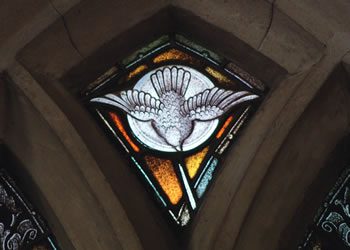 It is hard to find anything unprecedented in Christian Art. In 2,000 years most possibilities have been explored, but I must admit to not knowing of other examples of this artistic juxtaposition of the Annunciation and the Agony in the Garden.
It is hard to find anything unprecedented in Christian Art. In 2,000 years most possibilities have been explored, but I must admit to not knowing of other examples of this artistic juxtaposition of the Annunciation and the Agony in the Garden.
A scripture commentary published in 1914 – The Fourfold Gospel by J.W. McGarvey and Philip Pendleton – draws attention to the parallel:
Luke 1:38 And Mary said, Behold, the handmaid [Literally, “slave” or “bondservant.” It is the feminine form of the word which Paul so often applies to himself (Romans 1:1; Titus 1:1). Mary uses it to indicate her submissive and obedient spirit] of the Lord; be it unto me according to thy word. [In great faith she not only believes the promise, but its fulfilment. She bowed to the will of God like Eli (1 Sam 3:18), and became the mother of Him who prayed, “Not my will, but thine, be done” – Luke 22:42.] And the angel departed from her.
Perhaps the designer of the windows had read that text and thought how to illustrate it.
Stained glass windows look different in different lighting. A parishioner of long-standing confided in me that early in the morning the Holy Spirit is the first to catch the light and as the sun rises the gleam descends along the beam towards the virgin. Truly worthy and beautiful art will communicate different truths at different times; times of the day and times of your life.

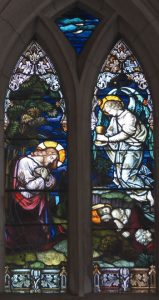
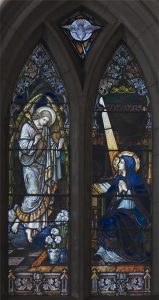
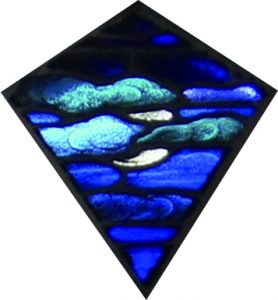
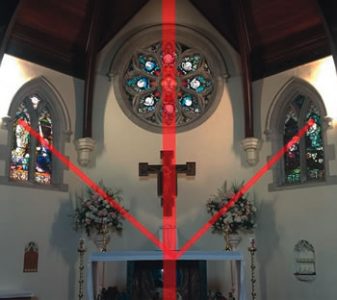
 Entries(RSS)
Entries(RSS)